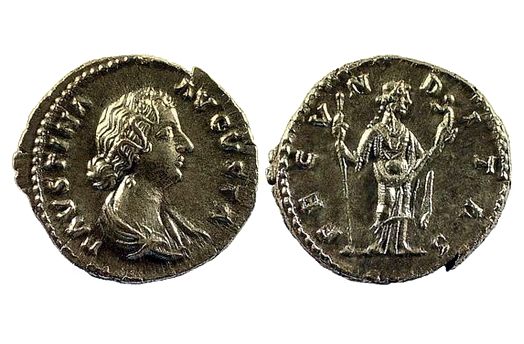
about ancient nomos
Ancient Nomos Art is a museum of galleries exhibiting ancient coins and ancient mint maps. The coin gallery displays the diverse art and history of hand-crafted ancient Greek, Roman, Byzantine, Persian and Medieval coinage. The ancient mints mapping gallery features Greek, Roman, Byzantine, Asia Minor and Medieval mint city regions and territories. Visitor's are welcome to explore, study and enjoy Ancient Nomos Art.

Imperial, Roman – 165 AD
Faustina Junior
From Ancient Galleries

Obverse: Draped bare head bust of Empress Faustina Junior facing right.
Reverse: Fecunditas standing facing with head turned holding sceptre and child.
LEGEND
Obv. FAVSTINA AVGVSTA, Draped bare head bust of Faustina Junior facing right wearing earring. Rev. FECVNDITAS, Fecunditas standing facing with head turned left, holding sceptre in right hand and child in raised left arm.
Empress Faustina Junior, named Anna Galeria, was the daughter of Faustina Senior and Emperor Antoninus Pius. She was likely born sometime during the latter half of the second decade of the 2nd century AD. After Antoninus adopted Marcus Aurelius as his son and heir to the throne, an arrangement was made for Faustina to marry Marcus in 145 AD. She quickly earned the Senate distinction of “Augusta” to the Empire, by virtue of Aurelius’ assured succession as next Emperor, even though Marcus was still “Caesar” to Antoninus. She was thought to be intelligent, tenacious and enduring, having given birth to at least 12 children and for being an able traveler alongside her husband during his many military campaigns to Parthia and Germany. Her lasting endurance and fortitude did not go unnoticed, for the Senate gave her a second honorable title, Mater Castrorum or ”Mother of the Military Camps” in the summer of 174 AD. Numerous coin types memorialize Faustina with beautifully engraved images struck on gold, silver and bronze denominations. The obverse coin above depicts a youthful Empress Faustina as the divine Augusta facing right. Her long hair is arranged into a small bun behind her neck with a graceful single wave of hair that wraps over linear strands of hair and into the bun. Waving strands of hair are arranged above with a long bead of pearls crowning between the layers of hair. The denarii reverse depicts Fecunditas, the matron goddess of fertility, growth and prosperity. She stands fully dressed, crowned and stands facing forward with her head turned left. She is raising a symbolic Roman infant upward in her left arm. She is also holding a long scepter in her right hand as a sign of protection. Regrettably, Faustina hastily announced the premature death of her Emperor husband to Avidius Cassius, then governor of Syria, in what some believe was a desire to sustain her imperial power and/or advance a love interest with Cassius. In either case, a subsequent Syrian military rebellion ensued, which the still alive Aurelius was able to quell after 100 days of fighting, resulting in the murder of Cassius and death of Faustina Junior a few months later near Cilicia in 175 AD.
DOCUMENTATION
Value: Denarius. Metal: AR Silver. Weight: 3.05 grams. Mint: Rome. Date: 161-180 AD.
Attribution: Roman Imperial Coinage III 677 (M. Aurelius); BMCRE 92; RSC 99a.
Legend, Documentation and Attribution
